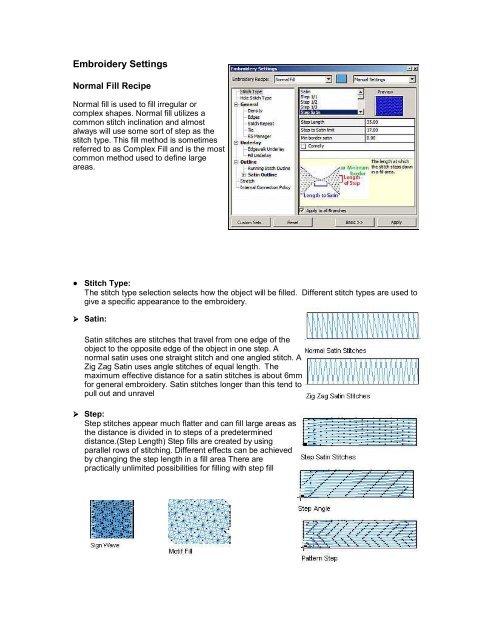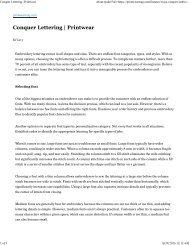Embroidery Basics Articles
Create successful ePaper yourself
Turn your PDF publications into a flip-book with our unique Google optimized e-Paper software.
<strong>Embroidery</strong> Settings<br />
Normal Fill Recipe<br />
Normal fill is used to fill irregular or<br />
complex shapes. Normal fill utilizes a<br />
common stitch inclination and almost<br />
always will use some sort of step as the<br />
stitch type. This fill method is sometimes<br />
referred to as Complex Fill and is the most<br />
common method used to define large<br />
areas.<br />
• Stitch Type:<br />
The stitch type selection selects how the object will be filled. Different stitch types are used to<br />
give a specific appearance to the embroidery.<br />
➢<br />
Satin:<br />
Satin stitches are stitches that travel from one edge of the<br />
object to the opposite edge of the object in one step. A<br />
normal satin uses one straight stitch and one angled stitch. A<br />
Zig Zag Satin uses angle stitches of equal length. The<br />
maximum effective distance for a satin stitches is about 6mm<br />
for general embroidery. Satin stitches longer than this tend to<br />
pull out and unravel<br />
➢<br />
Step:<br />
Step stitches appear much flatter and can fill large areas as<br />
the distance is divided in to steps of a predetermined<br />
distance.(Step Length) Step fills are created by using<br />
parallel rows of stitching. Different effects can be achieved<br />
by changing the step length in a fill area There are<br />
practically unlimited possibilities for filling with step fill




